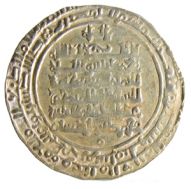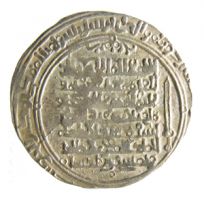Islamic Numismatics
Islamic Numismatics: A Survey


The coin as 'state bulletin' (sikka) gives in a minuscule script: the hierarchy of three rulers with their illustrious titles, the mint city, the month of issue, parts of three different verses of the Qur'an, and a sword, a tamgha, which is a heraldic device. Saljuqs of the East, Sultan Sanjar acknowledges Muhammad Tapar as supreme sultan, and the caliph in Baghdad as overlord. Dinar, Walwalij (present-day Qunduz), Muh.arram 493 H (Nov 17-Dec 16, 1099 CE); OMJ inv. no. 2003-17-017 (2.82g; 24mm).
Why Islamic Numismatics?
Historians of Islamic societies have almost no primary documents or archives at hand. In contrast secondary sources-literary and historical accounts-are abundant but only for the large centres. This gross imbalance between the scarcity of primary documents, produced in the course of the events, and chronicles written at a later time always with certain agendas of their own, has led modern scholars to depend greatly upon medieval but secondary authors. Yet, Islamic coins of the classical period are an abundant, continuous primary source of information produced in the course of the unfolding historical events.
Islamic coins can be characterised above all as bearers of texts of up to 150 words. The texts on coins struck during the first six and a half centuries of Islam often mention up to five names, providing the entire hierarchy of power-from the local governor up to the caliph at the time and location of minting. Is sequence of coins from one mint constitutes an independent narrative, being thus a textual source. No other civilization than the Islamic created coins as a reliable text document with legal and political consequences. As such, coins offer the often needed primary independent historical data that can be studied parallel in conjunction with the literary texts.
Thus coins stand as texts, material objects, designed items, archaeological artefacts, and subjects to legal considerations at the same time. They were continuously produced in many places and circulated as single coin or as a group thus found at many places. Islamic coins in particular constitute multi-faceted sources that can be exploited for historical research on a variety of topics in history, economics, religion, calligraphy, art, production and metal technology, and archaeological site chronology.
The current book project aims to be an introductory survey into Islamic numismatics for students of history, archaeology and Islamic art. Some of the topics are already delt with in different contexts. The range of the is indicated by the headings and associated publications are listed below.
A - Methods and Scholarly Directions in Islamic Numismatics.
Islamic numismatics developed as an offspring of the theology of Enlightenment and Oriental philology of the eighteenth century, rather than as a branch of Classical numismatics. After being widely neglected following World War One, the study and use of Islamic numismatics has re-emerged as prospering academic subject, particularly since the 1990s.
Islamische Numismatik in Deutschland (Islamic Numismatics in Germany). In: S. Heidemann (ed.): Islamische Numismatik in Deutschland - eine Bestandsaufnahme (Jenaer Beiträge zum Vorderen Orient 2), Wiesbaden 2000, pp. 1-16.
This history of Islamic numismatics in Germany explores the changing relation between Islamic numismatics and Islamic studies from the period of Enlightenment to modern development of area studies.
Zwischen Theologie und Philologie: Der Paradigmenwechsel in der Jenaer Orientalistik 1770 bis 1850 (Between Theology and Philology - The Paradigmatic Shift in Oriental Studies in Jena 1770-1780). In: Der Islam 84 (2008), pp. 140-184.
This article deals with the changing directions of scholarship in Oriental studies in the case of Jena University.
Der Paradigmenwechsel in der Jenaer Orientalistik in der Zeit der literarischen Klassik (The Paradigmatic Shift in Oriental Studies in Jena in the Literary Classical Age). In: Michael Hofmann - Charis Goers (eds.): Der Deutschen Morgenland. Bilder des Orients in der deutschen Literatur und Kultur von 1770 bis 1850, Munich 2008, p. 243-257 (abridged version of the latter).
Das Projekt, die Sylloge, der Bestand (The Project, the Sylloge, and the Relevant Holdings of the Oriental Coin Cabinet). In: Tobias Mayer: Sylloge der Münzen des Kaukasus und Osteuropas im Orientalischen Münzkabinett Jena (Orientalisches Münzkabinett Jena 1), Wiesbaden 2005, pp. xi-xxii.
As a preface for a sylloge-volume, this article compares different approaches used in Islamic numismatics.
Die Entwicklung der Methoden in der Islamischen Numismatik im 18. Jahrhundert - War Johann Jacob Reiske ihr Begründer? (The Development of Methods in Islamic Numismatics in the 18th Century. Was Johann Jacob Reiske its Founder?). In: Hans-Georg Ebert - Thoralf Hanstein (eds.): Johann Jacob Reiske: Persönlichkeit und Wirkung (Beiträge zur Leipziger Universitäts- und Wissenschaftsgeschichte 7), Leipzig 2005, pp. 147-202.
In the eighteenth century scholars explored for the first time the possibilities of Islamic numismatics and their contribution for art history, political history and archaeology.
B - Collections of Oriental Coins.
The history of the field is based on case studies of scholars, institutes and collections.
Collections of Oriental Coins in Germany. In: Oriental Numismatic Society Newsletter 179 (Spring 2004), p. 5-9. Abridged versions in Joachim Gierlichs - Annette Hagedorn (eds.): Islamic Art in Germany, Mainz, p. 25-28: in German as: Sammlungen Orientalischer Münzen in Deutschland. In: Joachim Gierlichs - Annette Hagedorn (eds.): Islamische Kunst in Deutschland, Mainz 2004, pp. 25-28.
A survey of collections of Islamic coins in Germany reflects the development of scholarship.
Jena
Das Orientalische Münzkabinett Jena - Die Islamische Münzkunde von der Theologie der Aufklärung zu den Regionalstudien (The Oriental Coin Cabinet in Jena - Islamic Numismatics from the Period of the Theology of Enlightenment to the Regional Studies). In: Gesellschaft der Freunde Islamischer Kunst und Kultur e.V. (ed.): Eothen IV (2007), pp. 95-120.
Maria Pawlowna und der Umbruch in der Orientalistik - Die Gründung des Großherzoglichen Orientalischen Münzkabinetts. (Maria Pawlowna and the Philological Turn in Middle Eastern Studies - The Foundation of the Grand-Ducal Oriental Coin Cabinet). In: Joachim Berger - Joachim von Puttkamer (eds.): Von Petersburg nach Weimar. Kulturelle Transfers von 1800 bis 1860 (Jenaer Beiträge zur Geschichte 9), Frankfurt a/M 2006, pp. 221-259.
Jemenitische Münzen in Jena. Zur Erforschung der jemenitischen Münzprägung (Yemenite Coins in Jena. About the Study of Yemenite Coinage). In: Jemen-Report. Mitteilungen der Deutsch-Jemenitische Gesellschaft e.V. vol. 35, no. 2 (2004), pp. 4-6.
Leipzig
Die orientalischen Münzen der Universitätsbibliothek in Leipzig - Eine Wiederentdeckung für die Forschung (The Oriental Coins at the University Library in Leipzig - A Re-Discovery for Research). In: Reiner Cunz (ed.) in connection with Rainer Polley and Andreas Röpcke: Fundamenta Historiae. Geschichte im Spiegel der Numismatik und ihrer Nachbarwissenschaften. Festschrift für Niklot Klüßendorf zum 60. Geburtstag am 10. Februar 2004 (Veröffentlichungen der urgeschichtlichen Sammlungen des Landesmuseums zu Hannover 51), Hannover 2004, pp. 339-352.
Gotha
Die verschollene Gothaer Sammlung orientalischer Münzen (The Missing Gotha Collection of Oriental Coins). In: S. Heidemann (ed.): Islamische Numismatik in Deutschland - eine Bestandsaufnahme (Jenaer Beiträge zum Vorderen Orient 2), Wiesbaden 2000, pp. 87-106.
C - Numismatic Surveys
address major issues and fields within Islamic numismatics.
Numismatics. In: Chase Robinson (ed.): The New Cambridge History of Islam, Volume 1: The Formation of the Islamic World, Sixth to Eleventh Centuries, Cambridge, UK 2010, pp. 648-663, 775-779, pl. 16.1-16.41.
This contribution surveys coins and coin circulation in the Islamic Empire from 6th to the beginning of the 12th century, when major reforms were intiated which form part of the transformation of Islamic societies in the middle Islamic period.
The Evolving Representation of the Early Islamic Empire and Its Religion on Coin Imagery. In: Angelika Neuwirth - Nicolai Sinai - Michael Marx (eds.): The Qur'an in Context: Historical and Literary Investigations into the Qur?anic Milieu (Text and Studies on the Qur'an 6), Leiden 2010, pp. 149-195.
The Standing Caliph-Type - The Object on the Reverse. In: Andrew Oddy (ed.): Coinage and History in the Seventh Century Near East, vol. 2, Proceedings of the 12th Seventh Century Syrian Numismatic Round Table held at Gonville and Caius College, Cambridge on 4th and 5th April 2009, London 2010, pp. 23-34.
The Merger of Two Currency Zones in Early Islam. The Byzantine and Sasanian Impact on the Circulation in Former Byzantine Syria and Northern Mesopotamia. In: Iran 36 (1998), pp. 95-112.
Das Geld der Mongolen (The Money of the Mongols). In: Antike Welt vol. 36 , no. 5 (2005), pp. 77-84.
Calligraphy on Islamic Coins. In: Jürgen Wasim Frembgen (ed.): The Aura of Alif. The Art of Writing in Islam, Munich 2010. German version: Kalligraphie auf islamischen Münzen. In: Die Aura des Alif. Schriftkunst im Islam, Munich et al 2010, pp. 161-172.
D - Archaeology and Numismatics:
How to construct reliable sources for the study of the political and economic history of a region and its hinterland by randomly found coins? Whether coins are found at archaeological sites in the thousands or as less than a handful, the sequence of coin finds from each site provides an independent source for economic and political history. Such local, site-specific histories can be aggregated to form a new perception of the inner workings of the Islamic empire. The studies on the archaeological coin finds from the Diyār Muḍar are listed under the Raqqa project.
Settlement Patterns, Economic Development and Archaeological Coin Finds in Bilād aš-Šām: the Case of the Diyār Mudar - The Process of Transformation from the 6th to the 10th Century A.D. In: Karin Bartl - Abd al-Razzaq Moaz (eds.): Residences, Castles, Settlements. Transformation Processes from Late Antiquity to Early Islam in Bilad al-Sham. Proceedings of the International Conference Held at Damascus, 5-9 November 2006 (Orient-Archäologie 24), Rahden 2009, pp. 493-516.
(The first part of this study answers the methodological questions how to work with coin finds and to reconstruct a source for settlement pattern of a region and for coin circulation. The second part is a case study)
Tall Rifa'at, east of Aleppo - Syria
Tall Rifa'at and Other Syrian Sites - Some Remarks [Review of J. Militký - V. Novak: Greek, Roman, Byzantine and Islamic Coins Excavated by Bedřich Hrozný in the Middle East (1924-1925). In: Annals of the Nárpstek Museum 23 (2002), p. 1-68)]. In: Annals of the Nárpstek Museum 24 (2003), pp. 91-95.
Masyaf - Isma'ili mountains, North-West Syria
Münzfunde aus der Zitadelle von Masyaf/Syrien (Coin Finds from the Citadel of Masyaf). In: Numismatisches Nachrichtenblatt vol. 55 (February 2006), pp. 74-75.
Bosra - Southern Syria
Fundmünzen aus dem Hammâm Manğak (Coin Finds from the Hammâm Manjak). In: Michael Meinecke - Fleming Aalund: Bosra. Islamische Architektur und Archäologie (Orient-Archäologie 17), Rahden 2005, pp. 145-146, plate 68.
Al-'Arqa - modern Akkar in Lebanon
An Early Islamic Coin from the Plain of Akkar . In: al-Usūr al-Wusţā 11, no. 2 (1999), p. 33.
Assur - Qal'at Shirqat, northern Iraq
with Peter A. Miglus: Fundmünzen aus Assur und Lokalgeschichte in Islamischer Zeit (Coin Finds from Assur and its Local History in the Islamic Period). In: Peter A. Miglus (ed.): Das Wohngebiet von Assur, Stratigraphie und Architektur (Wissenschaftliche Veröffentlichung der Deutschen Orientgesellschaft 93), Berlin (Gebr. Mann), p. 353-376.
Qaraqorum - Mongolia
with Hendrik Kelzenberg - Ulambayar Erdenebat - Ernst Pohl: The First Documentary Evidence for Qara Qorum from the Year 635/1237-8. In: Zeitschrift für Archäologie außereuropäischer Kulturen 1 (2006), pp. 93-102.
